LG Electronics USA E510G Cellular/PCS GSM/WCDMA/EDGE Phone with WLAN and Bluetooth User Manual LG E510g ENG 110819 105x63 BK indd
LG Electronics MobileComm USA, Inc. Cellular/PCS GSM/WCDMA/EDGE Phone with WLAN and Bluetooth LG E510g ENG 110819 105x63 BK indd
Users Manual

Some of the contents of this manual may not apply to your phone. This
depends on your phone’s software and your service provider.
This handset is not recommended for the visually impaired because of its
touch screen keyboard.
Copyright ©2011 LG Electronics, Inc. All rights reserved. LG and the LG
logo are registered trademarks of LG Group and its related entities. All other
trademarks are the property of their respective owners.
Google™, Google Maps™, Gmail™, YouTube™, Google Talk™ and
Android Market™ are trademarks of Google, Inc.
•
•
•
•
This guide helps you get started using your phone.
If you need more information, please visit www.lg.com.
LG-E510gLG-E510g User Guide
English

Part 15.21 statement
" Change or Modifications that are not expressly approved by the manufacturer could void
the user's authority to operate the equipment. “
Part 15.105 statement
This equipment has been tested and found to comply with the limits for a class B digital
device, pursuant to Part 15 of the FCC Rules.
These limits are designed to provide reasonable protection against harmful interference in
a residential installation. This equipment generates uses and can radiate radio frequency
energy and, if not installed and used in accordance with the instructions, may cause harmful
interference to radio communications. However, there is no guarantee that interference will
not occur in a particular installation. If this equipment does cause harmful interference or
television reception, which can be determined by turning the equipment off and on, the user
is encouraged to try to correct the interference by one or more of the following measures:
- Reorient or relocate the receiving antenna.
- Increase the separation between the equipment and receiver.
- Connect the equipment into an outlet on a circuit different from that to
which the receiver is connected.
- Consult the dealer or an experienced radio/TV technician for help.
This device is not intended for sale in the USA.

FCC Part 15 Class B Compliance
This device and its accessories comply with part 15 of FCC
rules and ICES-003 Class B digital apparatus requirements
for Industry Canada. Operation is subject to the following
two conditions:(1) This device and its accessories may not
cause harmful interference, and (2) this device and its
accessories must accept any interference received, including
interference that may cause undesired operation.
Body-worn Operation
This device was tested for typical body-worn operations
with the back of the phone kept 1.0cm (0.39 inches) between
the user’s body and the back of the phone. To comply with
FCC RF exposure requirements, a minimum separation
distance of 1.0cm (0.39 inches) must be maintained between
the user's body and the back of the phone. Third-party
belt-clips, holsters, and similar accessories containing
metallic components should not be used. Body-worn
accessories that cannot maintain 1.0cm (0.39 inches)
separation distance between the user's body and the back
of the phone, and have not been tested for typical body-
worn operations may not comply with FCC RF exposure
limits and should be avoided.

Conformité aux normes FCC Part 15 Class B
Cet appareil et ses accessoires sont conformes aux
normes FCC Part 15 Class B de la Federal
Communications Commission et aux exigences pour
appareils numériques ICES-003 Class B d’Industrie
Canada.Son fonctionnement est sujet aux deux conditions
suivantes :(1) Cet appareil et ses accessoires ne doivent
pas provoquer de brouillage préjudiciable, et (2) cet
appareil et ses accessoires doivent accepter toutes les
interférences reçues, y compris celles pouvant causer un
fonctionnement indésirable.
Utilisation comme appareil portatif
Ce téléphone a été testé en vue d’une utilisation type
comme appareil portatif, avec une distance de 1.0cm (0,39
pouces) entre l’arrière de l’appareil et le corps de
l’utilisateur. Pour satisfaire aux exigences de la FCC en
matière d’exposition aux radiofréquences, une distance
d’au moins 1.0cm (0,39 pouces) doit être maintenue entre
le corps de l’utilisateur et l’arrière du téléphone. Les
pinces de ceinture, les étuis et autres accessoires
semblables d’autres marques et contenant des
composantes métalliques ne doivent pas être utilisés.Les
accessoires portatifs empêchant le maintien d’une
distance de 1.0 cm (0,39 pouces) entre le corps de
l’utilisateur et l’arrière du téléphone et qui n’ont pas été
testés en vue d’une utilisation type comme accessoires
portatifs peuvent ne pas satisfaire aux limites d’exposition
aux radiofréquences stipulées par la FCC et, par
conséquent, ne doivent pas être utilisés.

To turn on your phone, press and hold the Power key for 3 seconds.
To turn off the phone, press and hold the Power key for 3 seconds, then touch Power off and OK.
Menu key
Check what options are available.
Home key
Return to home from any screen.
Back key
Return to the previous screen.
Speaker/Receiver
Power/Lock key
Switch your phone on/off by pressing and holding this key.
Turn off and lock the screen.
Proximity sensor
Getting to know your phone
Stereo earphone connector
Power/Lock key

Volume keys
On the home screen: control ringer
volume.
• During a call: control your earpiece
volume.
• When playing a track: control
volume continuously.
SIM card slot
microSD memory
card slot
Camera
lens
Charger, micro USB
cable connector
Battery
Back cover

NOTE: Proximity sensor
When receiving and making calls, the
proximity sensor automatically turns
the backlight off and locks the touch
keypad by sensing when the phone is
near your ear. This extends battery life
and prevents the touch keypad from
activating unintentionally during calls.
WARNING
Placing a heavy object on the phone
or sitting on, it can damage its LCD
and touch screen functions. Do
not cover the protective fi lm on the
LCD’s proximity sensor. This may
cause the sensor to malfunction.
Getting to know your phone
Installing the SIM card and
battery
To remove the back cover, hold the phone
in your hand firmly. With the other hand,
firmly press your thumb on the back
cover. Now lift off the battery cover.
1
Slide the SIM card into the SIM card slot.
Make sure the gold contact area on the
card is facing downwards.
2

Insert the battery by aligning the gold
contacts on the phone and the battery.
Replace the back cover of the phone.
3
4
Charging your phone
Slide open the cover of the charger
connector on the side. Insert the charger,
then plug it into an electrical outlet. Your LG-
E510g must be charged before you see .
NOTE: the
battery must be
fully charged
initially to
improve battery
lifetime.
Getting to know your phone
Installing the memory card
To store multimedia files, such as images
captured using the built-in camera, you must
insert a memory card into your phone.
NOTE: the LG-E510g supports memory
cards up to 32 GB.
To insert a memory card:
Turn the phone off before inserting or
removing a memory card. Remove the
back cover.
1

Insert the memory card into the slot.
Make sure the gold contact area is facing
downwards.
2
WARNING
Do not insert or remove the memory
card when the phone is on. Doing so
may damage the memory card as well
as your phone, and the data stored on
the memory card may be corrupted.
Getting to know your phone
Formatting the memory card
Your memory card may already be
formatted. If it isn’t, you must format it
before you can use it.
NOTE: all fi les on the card are deleted when
you format the card.
In the Home screen, touch the
Applications tab to open the applications
menu.
Scroll to and touch Settings > Storage,
then select Mass storage only.
Touch Unmount SD card.
1
2
3
Touch Erase SD card, then confirm your
choice.
If you have set a pattern lock, input
the pattern lock then select Erase
Everything. The card is then formatted
and ready to use.
NOTE: if there is content on your memory
card, the folder structure may be different
after formatting since all the fi les will have
been deleted.
4
5
Touch screen tips
Here are some tips on how to navigate
around your phone.
Touch – to choose a menu/option or open
an application, touch it.
Touch and hold – to open an options menu
or grab an object you want to move, touch
and hold it.
Drag – to scroll through a list or move
slowly, drag across the touch screen.
Flick – to scroll through a list or move
quickly, flick across the touch screen (drag
quickly and release).
NOTE:
To select an item, touch the centre of the
icon.
Do not press too hard; the touch screen
is sensitive enough to pick up a light, firm
touch.
Use the tip of your finger to touch the
option you want. Be careful not to touch
any other keys.
•
•
•
Your Home screen
Lock your phone
When you are not using the LG-E510g,
press the power key to lock your phone. This
helps prevent accidental presses and saves
battery power.
Also, if you do not use the phone for a while,
the Home screen or another screen you are
viewing is replaced with the lock screen to
conserve battery power.
If there are any programs running when you
set the pattern, they may be still running
in Lock mode. It is recommended that
you exit all programs before entering the
Lock mode to avoid unnecessary charges
(e.g. phone calls, Web access and data
communications).
Setting an unlock pattern: you can draw
your own unlock pattern by connecting the
dots.
If you set a pattern, the phone screen locks.
To unlock the phone, draw the pattern that
you set on the screen.
Caution: when you set an unlock pattern,
you need to create your Gmail account fi rst.
Caution: if there are more than 5 pattern
drawing errors in a row, you cannot unlock

the phone. In this case, your personal
information and downloaded data is
deleted.
Unlock screen
Whenever your LG-E510g is not in use, it
returns to the lock screen. Drag your finger
from bottom to top to unlock the screen.
Silent mode
In the notification drawer, touch
to be.
Home
Simply swipe your finger to the left or right
to view the panels.
You can customise each panel with widgets,
shortcuts (to your favourite applications),
folders and wallpaper.
NOTE: some screen images may be
different depending on your phone provider.
Your Home screen

In your Home screen, you can view quick
keys at the bottom of the screen. Quick
keys provide easy, one-touch access to the
functions you use the most.
Touch the Phone icon to bring up the
touch screen dialpad to make a call.
Touch the Contacts icon to open your
contacts.
Touch the Message icon to access the
messaging menu. This is where you can
create a new message.
Touch the Applications tab at the
bottom of the screen. You can then view all
your installed applications.
To open the desired application, simply touch
the icon in the applications list.
NOTE: preloaded applications may differ
according to your phone’s software or your
service provider.
Adding widgets to your Home
screen
You can customise your Home screen by
adding shortcuts, widgets or folders to it. For
more convenience using your phone, add
your favourite widgets to the Home screen.

In the Home screen, press the Menu key
and select Add. Or touch and hold the
empty part of the home screen.
In the Edit Mode menu, touch the type of
item you want to add.
For example, select Folders from the list
and tap it.
You then see a new folder icon on the
Home screen. Drag it to the desired
location on the desired panel, then take
your finger off the screen.
1
2
3
4
TIP! To add an application icon to the
Home screen from the Applications
menu, touch and hold the application
you want to add.
TIP!
To remove an application icon from
the Home screen, touch and hold the
icon you want to remove, then drag it
to .
NOTE: you cannot delete preloaded
applications. (Only their icons can be
deleted from the screen)
Your Home screen
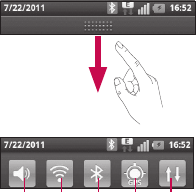
Returning to recently-used
applications
Touch and hold the Home key. The
screen displays a pop-up with icons of
applications you used recently.
Touch an icon to open the application.
Or touch the Back key to return to the
current application.
Notification drawer
The notification drawer runs across the top
of your screen.
1
2
Data
enabled
GPSBluetooth
Wi-Fi
Ring

Touch and slide the notification drawer down
with your finger.
Or, in the Home screen, press the Menu
key and select Notifications. Here you can
check and manage sound, Wi-Fi, Bluetooth
and GPS as well as other notifications.
Viewing the status bar
The status bar uses different icons to display
phone information such as signal strength,
new messages, battery life and active
Bluetooth and data connections.
Below is a table explaining the meaning of
icons you’re likely to see in the status bar.
[Status bar]
Your Home screen
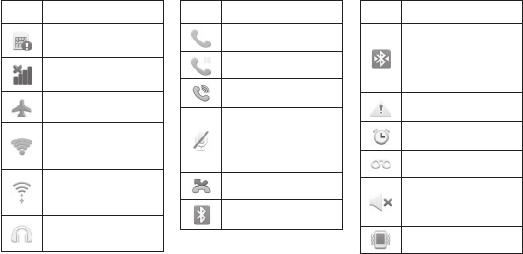
Icon
Description
No SIM card
No signal
Airplane mode
Connected to a Wi-
Fi network
Wi-Fi Direct is on.
Wired headset
Icon
Description
Call in progress
Call hold
Speakerphone
Phone microphone
is muted
Missed call
Bluetooth is on
Icon
Description
Connected to a
Bluetooth device
System warning
Alarm is set
New voicemail
Ringer is silenced
Vibrate mode
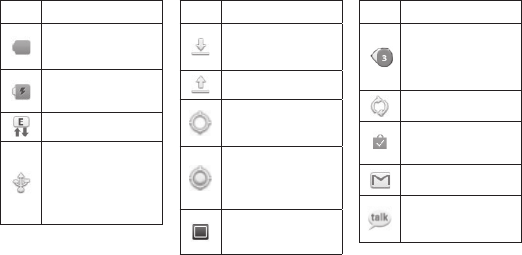
Icon
Description
Battery fully
charged
Battery is charging
Data in and out
Phone is connected
to PC via USB cable
Icon
Description
Downloading data
Uploading data
GPS is acquiring
Receiving location
data from GPS
On-Screen Phone
connected
Icon
Description
3 more notifications
not displayed
Data is syncing
Download finished
New Gmail
New Google Talk
message
Your Home screen
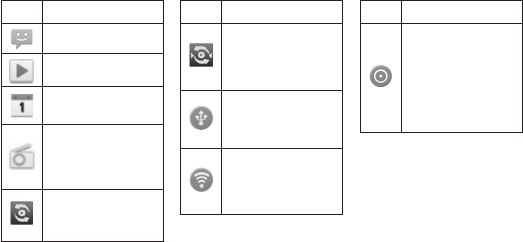
Icon
Description
New message
Song is playing
Upcoming event
FM radio turned on
in the background
SmartShare On
Icon
Description
SmartShare
sharing request
USB tethering is
active
Portable Wi-Fi
hotspot is active
Icon
Description
Both USB
tethering and
portable hotspot
are active

Onscreen keyboard
You can enter text using the onscreen
keyboard. The onscreen keyboard appears
automatically on the screen when you
need to enter text. To manually display the
keyboard, simply touch a text field where
you want to enter text.
Using the keypad & entering text
Tap once to capitalise the next letter you
type. Double tap for all caps.
Tap to switch to the numeric and
symbol keyboard. You can also touch and
hold this tab to view the Settings menu.
Tap to view or press and hold to change
the writing language.
Tap to insert an emoticon when writing a
message.
Tap to enter a space.
Tap to create a new line in the message
field.
Tap to delete the previous character.
Tap to hide the onscreen keyboard.
Your Home screen
Entering accented letters
When you select French or Spanish as the
text entry language, you can enter special
French or Spanish characters (e.g. “á”).
For example, to input "á", touch and hold
the "a" key until the zoom-in key grows
bigger and displays characters from different
languages.
Then select the special character you want.
When you first turn on your phone, you have
the opportunity to activate the network, to
sign into your Google Account and how you
want to use some Google services.
To set up your Google account :
* Sign into a Google Account from the
prompted set up screen.
OR
* Applications > select a Google appication,
such as Gmail > select Create to create a
new accout.
if you have a Google account, enter your e-
mail address and passwd, the touch Sign in.
Once you have set up your Google account
on your phone, your phone automatically
synchronises with your Google account on
the Web.
Your contacts, Gmail messages, Calendar
events and other information from these
applications and services on the Web are
synchronised with your phone. (This depends
on your synchronisation settings) .
Google account setup
After signing in, you can use Gmail™ and
take advantage of Google services on your
phone.

With Wi-Fi, you can use high-speed Internet
access within the coverage of the wireless
access point (AP).
Enjoy wireless Internet using Wi-Fi, without
extra charges.
Turning on Wi-Fi
From the Home screen, open the notification
drawer and touch .
Or touch Application > Settings >
Wireless & networks, then > Wi-Fi .
Connecting to Wi-Fi
Choose the Wi-Fi network you want to
connect to. If you see ,
you need to enter a password to connect.
NOTE:
if you are outside the Wi-Fi coverage area
and choose 3G connection, additional
charges may apply.
If your phone goes into sleep mode when
connected to Wi-Fi, the Wi-Fi connection is
automatically disabled.
•
•
Wi-Fi
In this case, if your phone has access to
3G data, it may connect to the 3G network
automatically and additional charges may
apply.
The LG-E510g supports WEP, WPA/WPA2-
PSK and 802.1x EAP security. If your Wi-Fi
service provider or network administrator
sets encryption for network security,
enter the key into the pop-up window.
If encryption is not set, this pop-up
window is not shown. Obtain the key from
your Wi-Fi service provider or network
administrator.
•
•
Sharing your phone’s data
connection
You can share your phone’s mobile data
connection with a single computer via a USB
cable (USB tethering). You can also share
your phone’s data connection with up to five
devices at a time by turning your phone into
a portable Wi-Fi hotspot.
When your phone is sharing its data
connection, an icon appears in the status
bar and as an ongoing notification in the
notifications drawer.

Icon Description
USB tethering is active
Portable Wi-Fi hotspot is active
Both USB tethering and portable
hotspot are active
For the latest information about tethering
and portable hotspots, including supported
operating systems and other details, visit
http://www.android.com/tether.
NOTE: additional costs may be incurred
when connecting and using online services.
Check data charges with your network
provider.
USB tethering & portable Wi-Fi
hotspot settings
In the Home screen, touch the
Applications tab and select Settings.
Touch Wireless & networks and select
Tethering & portable hotspot.
Choose options that you want to adjust.
1
2
3
Wi-Fi
USB tethering – tick to share your phone’s
mobile network data connection with your
computer via a USB connection.
Portable hotspot – tick to share your
phone’s mobile network data connection as
Wi-Fi sharing.
Help – opens a dialog with information
about USB tethering and portable Wi-Fi
hotspots as well as information on where to
learn more.
To share your phone’s data
connection via USB
If your computer is running Windows 7 or a
recent distribution of some flavours of Linux
(such as Ubuntu), you don’t usually need to
prepare your computer for tethering. But if
you’re running an earlier version of Windows
or another operating system, you may need
to prepare your computer to establish a
network connection via USB. For the most
current information about which operating
systems support USB tethering and how to
configure them, visit http://www.android.
com/tether.

USB tethering and data sharing
You can’t share your phone’s data
connection and microSD card via USB
at the same time. If you are using your
USB connection to make your microSD
card available to your computer, you must
disconnect it first.
Use the USB cable that came with your
phone to connect your phone to your
computer.
In the Home screen, touch the
Applications tab and select Settings.
1
2
Touch Wireless & networks and select
Tethering & portable hotspot.
Tick USB tethering.
The phone starts sharing its mobile
network data connection with your
computer via the USB connection. An
ongoing notification is added to the
status bar and notifications drawer.
Untick USB tethering to stop sharing
your data connection. Or just disconnect
the USB cable.
3
4
•
5
Wi-Fi

To share your phone’s data
connection as a portable Wi-Fi
hotspot
In the Home screen, touch the
Applications tab and select Settings.
Touch Wireless & networks and select
Tethering & portable hotspot.
Tick Portable hotspot.
After a moment, the phone starts
broadcasting its Wi-Fi network name
(SSID) so you can connect to it with up
to eight computers or other devices. An
ongoing notification is added to the
1
2
3
•
status bar and notifications drawer.
When Portable hotspot is ticked, you can
change its network name or secure it.
Untick Portable hotspot to stop sharing
your data connection via Wi-Fi.
To rename or secure your
portable hotspot
You can change the name of your phone’s
Wi-Fi network name (SSID) and secure its
Wi-Fi network.
In the Home screen, touch the
Applications tab and select Settings.
•
4
1
Touch Wireless & networks and select
Tethering & portable hotspot.
Ensure Portable hotspot is ticked.
Touch Portable hotspot settings.
Touch Configure Wi-Fi hotspot.
The Configure Wi-Fi hotspot dialog
opens.
You can change the network SSID (name)
that other computers see when scanning
for Wi-Fi networks.
You can also touch the Security menu to
configure the network with Wi-Fi Protected
2
3
4
5
•
•
•
Access 2 (WPA2) security, with a pre-
shared key (PSK).
If you touch the WPA2 PSK security
option, a password field is added to the
Configure Wi-Fi hotspot dialog. If you
enter a password, you will need to enter
that password when you connect to the
phone’s hotspot with a computer or other
device. Or touch Open in the Security
menu to remove security from your Wi-Fi
network.
•
Wi-Fi

ATTENTION!
If you set the security option as Open,
you cannot prevent unauthorised usage
of online services by other people and
additional charges can be incurred.
To avoid unauthorised usage, you are
advised to keep the security option
active.
Touch Save.
6
Enabling Wi-Fi Direct to share
through SmartShare
Wi-Fi Direct cannot be enabled while using
other Wi-Fi functions.
Wi-Fi Direct automatically scans nearby Wi-
Fi Direct devices and the searched devices
will be listed up in the order of arrival and
you can select a specific device to share
multimedia data through SmartShare.
On the home screen, touch the
Application tab and select Settings.
Touch Wireless & networks and select
Wi-Fi Direct Settings.
1
2
Ensure Wi-Fi Direct is selected.
Select a device to connect in the scanned
device list.
Forced Group owner mode – Touch to
activate group owner mode that enables the
legacy Wi-Fi devices to connect by scanning
your phone.
In this case you must enter the password
that is set in the Menu > Advanced >
Password.
NOTE: When your phone becomes group
owner, it will consume more battery power
than being a client. Wi-Fi Direct connection
3
4
does not provide Internet service. Additional
cost may be incurred when connecting and
using online services. Check data charges
with your network provider.
Using the Wi-Fi Cast
You can share your music, picture and video
contents between users who use Android
Phone connected via same Wi-Fi & Wi-Fi
Directed network.
Check your Wi-Fi & Wi-Fi Directed network
in advance and make sure same network is
connected between the users.
Wi-Fi
On the home screen, touch the
Application tab and select Settings.
Touch Wireless & networks and select
Wi-Fi Direct Settings.
Ensure Wi-Fi Direct is selected and
select a device to connect in the scanned
device list.
Touch Connect.
NOTE:
Wi-Fi cast is activated between the users.
Make sure to connect to same Wi-Fi
Network between the users.
1
2
3
4

How to use On-Screen Phone
On-Screen Phone allows you to view your
mobile phone screen from a PC via a USB or
Bluetooth connection.
You can also control your mobile phone from
your PC using the mouse or keyboard.
On-Screen Phone icons
Connects your mobile phone to your PC,
or disconnects it.
Rotates the On-Screen Phone window
(only available at applications that
support rotation).
Changes the On-Screen Phone
preferences.
Exits the On-Screen Phone program.
Minimises the On-Screen Phone
window.
On-Screen Phone features
Real-time transfer and control: displays
and controls your mobile phone screen
when connected to your PC.
Mouse control: allows you to control your
mobile phone by using the mouse to click
and drag on your PC screen.
•
•
On-Screen Phone
Text input with keyboard: allows you to
compose a text message or note using
your computer keyboard.
File transfer (mobile phone to PC): sends
a file from your mobile phone (e.g. photos,
videos, music and Polaris viewer files) to
your PC. Simply right-click and drag to
send a file to your PC.
File transfer (PC to mobile phone): sends
files from your PC to your mobile phone.
Simply select the files you wish to transfer
and drag and drop into the On-Screen
Phone window. The files you send are
•
•
•
stored on a micro SD card.
Real-time event notifications: prompts
a pop-up to inform you of any incoming
calls or text, as well as alarm and event
notifications.
How to install On-Screen Phone
on your PC
If you install LG PC Suite IV, the On-Screen
Phone program will also be downloaded on
your PC. Then you can install the On-Screen
Phone on your PC.
•
How to connect your mobile
phone to your PC
USB connection:
Open Connection Wizard, select "USB
Cable connection" and click "Next".
Connect your mobile phone to the PC
using a USB cable and click "Next".
Enter the On-Screen Phone password
and click "Next". The default password is
"0000". You can change the password in
Settings > Wireless & networks > On-
Screen Phone Settings.
1
2
3
Click "OK" to exit the window.
NOTE: Go to Settings > Storage and
make sure that the “Mass storage only”
checkbox is deselected.
Wireless connection with Bluetooth:
On your mobile phone, go to Settings
> Wireless & networks > Bluetooth
settings. Select Turn on Bluetooth and
select Discoverable.
If you have previously connected using a
cable, run the New Connection Wizard to
create a new connection.
4
1
2
On-Screen Phone
Run the Connection Wizard on the
computer, select "Bluetooth connection",
then "Next".
The wizard starts searching for Bluetooth-
enabled mobile phones. When the
mobile phone that you wish to connect to
appears, click "Stop" to stop searching.
Select "LG-E510g" from the device list
and click "Next". You can rename the
device if you wish.
Enter the PIN code (e.g. "0000") and
click "Next".
3
4
5
6
On your mobile phone, accept the request
and check the same PIN code, then touch
"OK".
Enter the On-Screen Phone password
and click "Next" (the default password is
"0000").
Touch "OK" to exit.
To check the phone to PC
connection
Once the devices have been connected, drag
down the notification bar at the top of the
home screen to check the On-Screen Phone
connection status.
7
8
9

To disconnect your phone from
your PC
Click in the top left of the On- Screen
Phone window. Or drag down the notification
bar at the top of the home screen and select
"On-Screen Phone". Touch "Yes" in the
Disconnect window.
NOTE: You must restart your phone after
shutting down the On-Screen Phone
service.
On-Screen Phone
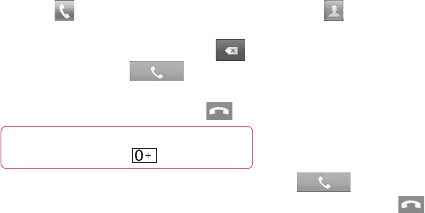
Making a call
Touch to open the keypad.
Enter the number using the keypad. To
delete a digit, touch the Clear icon .
Touch the Call icon to make
a call.
To end a call, touch the End icon .
TIP!
To enter “+” to make international
calls, touch and hold .
1
2
3
4
Calling your contacts
Touch to open your contacts.
Scroll through the contact list or enter the
first letter(s) of the contact you want to
call by touching Search.
In the list, touch the contact you want
to call.
Answering and rejecting a call
When your phone rings, drag the Answer
icon to the right.
Drag the Decline icon to the left to
reject an incoming call. Drag the Excuse
1
2
3
Calls

messages bar from the bottom if you want
to send one. If the caller is unknown, the
Excuse messages bar is not available.
TIP! Excuse messages
When you reject a call, you can send
a message quickly by touching Send
SMS. This is useful if you need to reply
the message during a meeting.
Adjusting call volume
To adjust the in-call volume during a call,
use the Volume Up and Down key on the left
side of the phone.
Making a second call
During your initial call, touch Dialpad.
Dial the number, or search your contacts.
Touch the Call icon to connect
the call.
Both calls are displayed on the call
screen. Your initial call is locked and put
on hold.
Touch the displayed number to toggle
between calls. Or touch Merge calls
to make a conference call.
To end active calls, touch End. To end
all calls at the same time, slide the
1
2
3
4
5
6
Calls

notification bar down and select End
calls.
NOTE: you are charged for each call you
make.
Viewing your call logs
In the Home screen, touch and choose
the Call log tab.
View a complete list of all dialled, received
and missed voice calls.
TIP!
Touch any call log entry
to view the date, time and duration of
the call.
TIP! Press the Menu key,
then touch Delete all to delete all the
recorded items.
Call settings
You can configure phone call settings such
as call forwarding and other special features
offered by your carrier.
In the Home screen, touch the
Applications tab to open the applications
menu.
Scroll and touch Settings.
Tap Call settings and choose the options
that you want to adjust.
1
2
3

Add contacts to your phone and synchronise
them with the contacts in your Google
account or other accounts that support
contact syncing.
Searching for a contact
In the Home screen
Touch to open your contacts.
Touch Search and enter the contact
name using the keyboard.
1
2
Adding a new contact
Touch , enter the new contact’s
number, then press the Menu key. Touch
Add to contacts and then Create new
contact.
If you want to add a picture to the new
contact, touch .
Choose from Capture picture or Pick
from Gallery.
Select the contact type by touching .
Touch a category of contact information
and enter the details about your contact.
Touch Save.
1
2
3
4
5
Contacts

Favourite contacts
You can classify frequently called contacts
as favourites.
Adding a contact to your favourites
Touch to open your contacts.
Touch a contact to view its details.
Touch the star to the right of the contact’s
name. The star turns gold.
1
2
3
Removing a contact from your favourites
list
Touch to open your contacts.
Touch the Group tab, select Favorites at
the top of the list and choose a contact to
view its details.
Touch the yellow star to the right of the
contact’s name. The star turns grey
and the contact is removed from your
favourites.
1
2
3
Moving contacts from your old
phone to your new phone
Export your contacts as a CSV file from
your old phone to your PC using a PC
sync program.
Download PC Suite IV from www.lg.com
and install it on the PC. Run the program
and connect your Android mobile phone
to the PC using the USB cable.
Select the Contacts icon. Go to Menu
> File > Import and select the CSV file
saved on your PC.
1
2
If the fields in the imported CSV file are
different from those in PC Suite IV, you
need to map the fields. After mapping
the fields, click OK. The contacts are then
added to PC Suite IV.
If PC Suite IV detects the connection of
your LG-E510g phone (using the USB
cable), click Sync or Sync contacts to
synchronise the contacts saved on your
PC with your phone.
3
4
Contacts

Messaging
Your LG-E510g combines SMS and MMS
into one intuitive, easy-to-use menu.
Sending a message
Touch icon on the home screen, and
touch New message to open a blank
message.
Enter a contact name or contact number
in the To field. As you enter the contact
name, matching contacts appear. You can
touch a suggested recipient. You can add
multiple contacts.
1
2
NOTE: You will be charged for a text
message for every person you send the
message to.
Touch type to compose below to start
entering your message.
Press the Menu key to open the options
menu. Choose from Add subject, Attach,
Send, Insert smiley and More.
Touch Send to send your message.
The message screen opens, with your
message after your name. Responses
appear on the screen. As you view and
send additional messages, a message
thread is created.
3
4
5
6
Messaging/email

WARNING: The 160-character
limit may vary from country to country
depending on how the SMS is coded
and in what language.
WARNING: If an image, video, or
audio fi le is added to an SMS message,
it will be automatically converted into an
MMS message, and you will be charged
accordingly.
NOTE:
When you get an SMS message
during a call, there will be a ring notifi cation.
Threaded box
Messages (SMS, MMS) exchanged
with another party can be displayed
in chronological order so that you can
conveniently see an overview of your
conversation.
Using Smilies
Liven up your messages using Smilies.
When writing a new message, press the
Menu key, then choose Insert smiley.
Messaging/email

Changing your message settings
Your LG-E510g message settings are
predefined, so you can send messages
immediately. You can change the settings
based on your preferences.
WARNING: In this mode, the MMS
Client device guides the user in creating
and sending messages with content
belonging to the Core MM Content
Domain. This guidance is provided
through warning dialogs.
Opening Email and the Accounts
Screen
You can use the Email application to read
email from services other than Google Mail.
The Email application supports the following
account types: POP3, IMAP and Exchange.
To open the Email application
From the Home screen, touch Email.
Select Email Service Provider.
A setup wizard opens to help you add an
email account. After the initial setup, Email
displays the contents of your Inbox (if you

have only one account) or the Accounts
screen (if you have multiple accounts).
The Accounts screen
The Accounts screen lists your Combined
Inbox and each of your email accounts.
Open the Email application. If you’re not
on the Account screen, press the Menu
Key and touch Accounts.
Select the Email service provider.
- Touch to open your Combined Inbox,
with messages sent to all of your
accounts.
1
2
- Touch to open a list of just your
starred messages.
- Touch the folder icon to open the
account’s folders.
You can touch an account to view its Inbox.
The account from which you send email by
default is indicated with a tick.
To open your Combined Inbox
If you have configured Email to send and
receive email from more than one account,
you can view all messages sent to all
accounts in your Combined Inbox.
Messaging/email
Touch Email.
Touch Combined Inbox (in the Accounts
screen). Messages in the Combined Inbox
are colour coded along their left sides, by
account, using the same colours that are
used for your accounts in the Accounts
screen.
Only your account’s most recent emails are
downloaded to your phone. To download
more (earlier) email messages, touch Load
more messages at the bottom of the
emails list.
1
2
Composing and Sending Email
To compose and send a message
While in the Email application, press the
Menu Key and touch Compose.
Enter an address for the message’s
intended recipient. As you enter text,
matching addresses are offered from your
Contacts. Separate multiple addresses
with commas.
Press the Menu Key and touch Add
Cc/Bcc to be able to Cc or Bcc other
contacts/email addresses.
Enter the text of the message.
1
2
3
4

Press the Menu Key and touch Add
Attachment to send a file with the
message.
Touch the Send button.
If you’re not ready to send the message,
touch the Save as draft button to save it
in a Drafts folder. Touch a draft message
in a Drafts folder to resume working on
it. Your message will also be saved as
a draft if you touch the Back Key
before sending it. Touch the Discard
button to abandon and delete a message,
including any saved drafts. If you aren’t
5
6
connected to a network, for example,
if you’re working in airplane mode, the
messages that you send are stored in
your Outbox folder until you’re connected
to a network again. If it contains any
pending messages, the Outbox is
displayed on the Accounts screen.
Please note that messages sent using an
Exchange account will not be located on the
phone; they will, however, be located on the
Exchange server itself.
If you want to see your sent messages in the
Sent folder (or with the Sent label), you will
Messaging/email

often need to open the Sent folder/label and
select Refresh from the options menu.
TIP! When a new email arrives in the
inbox, you will receive a notifi cation
by sound or vibration. Tap the email
notifi cation to stop notifi cations.
Working with Account Folders
Each account has Inbox, Outbox, Sent, and
Drafts folders. Depending on the features
supported by your account’s service provider,
you may have additional folders.
Adding and Editing Email
Accounts
To add an email account
Press the Menu Key and touch Add
account.
Select MS Exchange or Others, and enter
account settings.
Enter a name for the account, confirm
how you want your name to appear in
outgoing mail, then touch the Done
button.
1
2
3
To change an account’s settings
Open the Accounts screen.
Touch and hold the account whose
settings you want to change. In the menu
that opens, touch Account settings.
To delete an email account
Open the Accounts screen.
Touch and hold the account you want to
delete.
Touch Remove account in the menu
that opens.
Touch the OK button in the dialog box
to confirm that you want to delete the
account.
1
2
1
2
3
4
Social Networking
With your phone, you can take advantage of
social networking and manage your micro-
blog in on-line communities. You can update
your current status, upload photos, and view
your friends’ status updates in real-time.
You can add your Facebook and Twitter
accounts to your phone. If you don’t have an
account, you can visit their sites to set it up.
NOTE: Additional costs may be incurred
when connecting and using online services.
Check your data charges with your network
provider.
Messaging/email

Adding your account to your
phone
On the home screen, choose any SNS
application you want to use.
If you don't yet have an account, touch
Sign up now and input details.
Enter the e-mail address and password
that you set up on your community, then
tap Log in.
Wait while your details are checked with
your community.
1
2
3
4
Check your community is turned ON. If
you tap your community, you can see the
current status of your social community.
TIP! If you add a social networking
widget on your home screen, the widget
will show your status when your phone
updates from the network.
You can also access the social
community directly by touching the
widget.
5

Viewing and updating your
status
Choose a community you want to access.
You can see the current status of your
social community.
You can update your status with
comments or by uploading photos.
NOTE: This is dependent on network
services.
TIP!
You can use information
about friends only in SNS or sync all
data to Contacts.
1
2
3
Removing accounts on your
phone
Choose Settings > Accounts & sync >
Choose an account you want to delete >
Touch Remove account.
Messaging/email

Zoom - zoom in or zoom out. Alternatively you can use the side
volume keys.
Brightness - this defines and controls the amount of sunlight entering
the image. Slide the brightness indicator along the bar towards “-” to
lower the brightness of the image or towards “+” to increase it.
Scene mode - choose from Auto, Portrait, Landscape, Sports,
Night and Sunset.
Image size - touch to set the size (in pixels) of the picture you take.
Settings - touch this icon to open the Settings menu. See 'Using the
advanced settings'.
Video mode - slide this icon down to switch to video mode.
Taking a photo
Gallery - touch to view the last photo you captured. This enables you
to access your gallery and view saved photos from within camera
mode.
TIP! Close all shortcut options to give a
clearer viewfi nder screen. Touch the centre of
the viewfi nder once. To display the options,
touch the screen again.
Camera
Getting to know the
viewfinder

Taking a quick photo
Open the Camera application.
Hold the phone horizontally and point
the lens towards the subject you want to
photograph.
In the centre of the viewfinder screen, a
focus box starts blinking as it tries to get
the subject in focus.
The focus box turns green when the
subject is in focus.
Press the capture button. You can press
the capture button whether the focus box
is green or not.
1
2
3
4
5
Press the capture button.
Once you’ve taken the photo
Your captured photo appears on the screen.
Share
Touch to share your photo using
SmartShare, Bluetooth, E-mail,
Gmail, Messaging, Picasa or
Social+.
NOTE: additional charges may apply when
MMS messages are downloaded while
roaming.
6
Camera
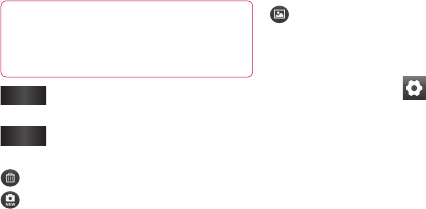
TIP! If you have an SNS account
and set it up on your phone, you
can share your photo with the SNS
community.
Set as
Touch to use the image as a
Contact icon or wallpaper.
Rename
Touch to edit the name of the
picture just taken.
Touch to delete the image.
Touch to take another photo
immediately. Your current photo is
saved.
Touch to view a gallery of your saved
photos.
Using the advanced settings
In the viewfinder, touch to open all
advanced options.
Change camera settings by scrolling through
the list. After selecting the option, touch the
Back key.
ISO – the ISO rating determines the
sensitivity of the camera’s light sensor.
The higher the ISO, the more sensitive the
camera is. This is useful in darker conditions
when you cannot use the flash. Select from
ISO values of Auto, 400, 200 and 100.
White balance – choose from Auto,
Incandescent, Sunny, Fluorescent and
Cloudy.
Color effect – choose a colour tone for your
new photo.
Timer – the self-timer allows you to set a
delay after the capture button is pressed.
Select Off, 3 secs., 5 secs. or 10 secs. This
is ideal if you want to be in the photo.
Image quality – choose from Super fine,
Fine and Normal. The finer the quality, the
sharper the photo. However, the file size
increases as a result, which means you can
store fewer photos in the memory.
Auto review – if you turn Auto review on,
it automatically shows you the picture you
just took.
Shutter sound – select one of four shutter
sounds.
Tag location – activate to use your phone’s
location-based services. Take pictures
wherever you are and tag them with the
Camera

location. If you upload tagged pictures to a
blog that supports geotagging, you can see
the pictures displayed on a map.
NOTE: this function is only available when
GPS is active.
– Restore all camera default settings.
– Touch whenever you want to know
how this function operates. This provides you
with a quick guide.
TIP!
When you exit the camera, some
settings return to their defaults, such as
white balance, colour tone, timer and
scene mode. Check these before you
take your next photo.
TIP!
The Settings menu is superimposed
over the viewfi nder so, when you change
elements of the image colour or quality,
you see a preview of the image change
behind the Settings menu.
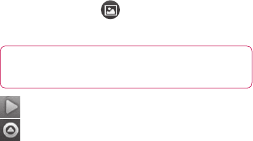
Viewing your saved photos
Access your saved photos while in Camera
mode. Just touch and touch the screen.
You then see Slideshow and Menu.
TIP!
Flick left or right to view
other photos or videos.
- Touch to see a slideshow.
- Touch to share the contents or delete a
photo. Touch More for more options.
Details – check information on the
content.
Set as – set as a contact icon or
wallpaper.
Crop – crop your photo. Move your
finger across the screen to select the
area.
Rotate – rotate left or right.
Camera
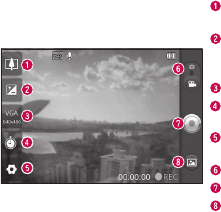
Zoom - zoom in or zoom out. Alternatively you can use the side
volume keys.
Brightness - this defines and controls the amount of sunlight entering
the video. Slide the brightness indicator along the bar towards “-” to
lower the brightness of the video or towards “+” to increase it.
Video size - touch to set the size (in pixels) of the video you record.
Duration - set a duration limit for your video. Choose between Normal
and MMS to limit the maximum size to send as an MMS message.
Settings - touch this icon to open the settings menu. See 'Using the
advanced settings'.
Camera mode - slide this icon up to switch to camera mode.
Start recording
Gallery - touch to view the last video you recorded. This enables you
to access your gallery and view your saved videos from within video
mode.
Getting to know the
viewfinder
Video camera

Shooting a quick video
Slide the Camera mode button down and
the icon changes to .
The video camera viewfinder appears on
the screen.
Holding the phone horizontally, point the
lens towards the subject you want to
capture in your video.
Press the Record button once to start
recording.
REC appears at the bottom of the
viewfinder with a timer showing the
length of the video.
1
2
3
4
5
Touch on the screen to stop
recording.
After shooting a video
A still image representing your video will
appear on the screen.
Play Touch to play the video.
Share Touch to share your video using
SmartShare, Bluetooth, E-mail,
Gmail, Messaging or YouTube.
NOTE: additional charges may apply when
MMS messages are downloaded while
roaming.
6
Video camera

Rename Touch to edit the name of the
selected video.
Touch to shoot another video right away.
Your current video is saved.
Touch to delete the video you just made.
Confirm by touching Yes. The viewfinder
reappears.
Touch to view a gallery of your saved
videos.
Using the advanced settings
Using the viewfinder, touch to open all
the advanced options.
Adjust the video camera setting by scrolling
through the list. After selecting the option,
touch the Back key.
White balance – white balance ensures
that the white areas in your video are
realistic. To enable your camera to adjust
the white balance correctly, you may need to
determine the light conditions. Choose from
Auto, Incandescent, Sunny, Fluorescent
and Cloudy.

Color effect – choose a colour tone to use
for your new view.
Video quality – choose from Super fine,
Fine and Normal.
Audio recording – choose Mute to record a
video without sound.
Auto review – auto review automatically
shows you the video you just recorded.
– Restore all video camera default
settings.
– Touch if you want to know how this
function operates. This provides you with a
quick guide.
Watching your saved videos
In the viewfinder, touch .
Your gallery appears on the screen.
Touch a video once to bring it to the
front of the gallery. It starts playing
automatically.
Adjusting the volume when
viewing a video
To adjust the volume of a video while it is
playing, use the volume keys on the left-
hand side of the phone.
1
2
3
Video camera

You can store multimedia files on a memory
card to have easy access to all your image
and video files.
Touch the Applications tab, then select
Gallery. Open a list of catalogue bars that
store all your multimedia files.
NOTE:
make sure you install
a memory card in the phone to save
photos and access all your pictures.
Without a memory card, the phone does
not display photos or videos without
Picasa images, which are in your Picasa
album.
View mode
Touch Gallery. Folder view is displayed.
Touch any folder and it turns to grid view
mode. If you tap a photo, it changes into full
view mode.
Timeline view
LG-E510g Gallery provides a timeline view
of your photos and videos. In grid view
mode, drag to the right and the date
you took your photos is displayed, starting
with the most recent. If you select a specific
date, all the photos you took on that day are
grouped.
Multimedia
Using SmartShare
SmartShare provides you with a better way
to enjoy multimedia contents with other
DLNA (Digital Living Network Alliance)
enabled devices.
* Share your media contents with other
DLNA devices (DMS)
In the Home screen, touch the
Applications tab and select
SmartShare.
Press the Menu key and select Settings.
Touch the Discoverable tickbox to turn on.
1
2
3
You can change your device name, icon
and select the sharing content types.
* Let your renderer device (e.g. TV)
play multimedia contents from remote
content library (e.g. PC)
Touch the top right button to select the
device from a list of renderers.
Touch the top left button and select a
remote content library.
You can browse the remote content
library.
Touch a content thumbnail or press the
Menu key and select the Play button.
4
1
2
3
4
Multimedia

Notice: check that your device is connected
to your home network using a Wi-Fi
connection in order to use this application.
Notice: some DLNA-enabled devices (e.g.
TV) support only DMP features of DLNA and
will not appear in the renderer device lists.
Music
Your LG-E510g has a built-in music player
that lets you play all your favourite tracks. To
access the music player, touch Music.
Playing a song
In the Home screen, touch the
Applications tab and select Music.
Touch Songs.
Select the song you want to play.
Touch to pause the song.
Touch to skip to the next song.
Touch to go back to the beginning
of the song. Touch twice to return to
the previous song.
1
2
3
4
5
6

To change the volume while listening to
music, press the up and down volume keys
on the left-hand side of the phone.
Touch and hold any song in the list. It
displays Play, Add to playlist, Use as
phone ringtone, Delete, Details, Share and
Search as options.
NOTE:
music fi le copyrights may be
protected by international treaties and
national copyright laws.
Therefore, it may be necessary to obtain
permission or a licence to reproduce or
copy music.
In some countries, national laws prohibit
private copying of copyrighted material.
Before downloading or copying the fi le,
check the national laws of the relevant
country concerning the use of such
material.
Multimedia
Transferring files using USB
mass storage devices
To transfer files using USB devices
Connect the LG-E510g to a PC using a
USB cable.
If you haven't installed LG Android
Platform Driver on your PC, you need to
change the settings manually. Choose
Settings > Storage, then select Mass
storage only.
Touch Turn on USB storage.
You can view the mass storage contents
on your PC and transfer the files.
1
2
3
4
NOTE: you need to install an SD card fi rst.
Without an SD card, you cannot use USB
mass storage.
NOTE:
if you installed LG Android Platform
Driver, you will immediately see a pop-up
saying Turn on USB storage.
How to save music/video files on
your phone
Connect your phone to the PC using the
USB cable. In the Home screen, touch
and drag the status bar down. Select
USB connected > Turn on USB storage
> Open folder to view files.
1
If you didn't install LG Android Platform
Driver on your PC, you must set it up
manually.
For more information, refer to
'Transferring files using USB mass
storage devices'.
Save music or video files from the PC to
the phone's removable storage.
You can copy or move files from your
PC to your phone's removable storage
using a card reader.
If there is a video file with a subtitle file
(*.srt file with the same name as the
2
•
•
video file), place it in the same folder
to display subtitles automatically when
playing the video file.
When downloading music or video files,
copyrights must be secured. Note that
corrupted files or files with incorrect
extensions may damage your phone.
Sending data from your phone
using Bluetooth
Sending data using Bluetooth You can
use Bluetooth to send data by running a
corresponding application, not from the
•
Multimedia
Bluetooth menu as on most other mobile
phones.
* Sending pictures: run the Gallery
application, then select Picture > Menu.
Click Share, then select Bluetooth. Check
whether Bluetooth is turned on, then select
Scan for devices. Choose the device you
want to send data to from the list.
* Exporting contacts: run the Contacts
application. Touch the address you want
to export to. Press the Menu key and
select Share > Bluetooth. Check whether
Bluetooth is turned on, then select Scan
for devices. Choose the device you want
to send data to from the list.
* Sending multi-selected contacts: run
the Contacts application. To select more
than one contact, press the Menu key and
touch Share > Multiselect. Select the
contacts you want to send or press the
Menu key and touch Select all > Share
> Bluetooth. Check whether Bluetooth is
turned on, then select Scan for devices.
Choose the device you want to send data
to from the list.
* Connecting to FTP (only FTP server
is supported on this handset): select
Settings > Wireless & networks
> Bluetooth Settings. Select the
Discoverable box so you can search for
your phone on other devices. Find the FTP
service and connect to the FTP server.
If you want to search for this phone from
other devices, go to Settings > Wireless
& networks > Bluetooth Settings. Select
the Discoverable box. The box is cleared
after 120 seconds.
•
Radio
Your LG-E510g has a built-in FM radio so
you can tune in to your favourite stations
and listen on the go.
NOTE:
you must attach your headphones
to listen to the radio. Insert them into the
headphone jack.
Searching for stations
You can tune in to radio stations
by searching for them manually or
automatically. They are then saved to
specific channel numbers, so you don't have
to find them again.
Multimedia
You can store up to 48 channels on your
phone.
Tuning in automatically
In the Home screen, touch the
Applications tab and select FM Radio.
Press the Menu key, then touch Auto
scan.
If there are preset channels, you will see
a pop-up asking "Reset all channels and
start auto scan?". If you choose OK, all
the preset channels are deleted and Auto
scan starts.
1
2
3
During auto scanning, touch Stop if you
want to stop scanning. Only scanned
channels are saved before you stop
scanning.
NOTE: you can also manually tune in to a
station using the displayed wheel.
Resetting channels
Press the Menu key and choose Reset
channel to reset the current channel, or
choose Reset all channels to reset all the
channels.
4

Listening to the radio
Touch Listen Via to set the speaker or
headset to listen to the radio.
TIP! To improve radio reception,
extend the headset cord as this also
functions as the radio antenna.
WARNING
If you connect a headset not specifi cally
made for radio reception, radio reception
may be poor.
Multimedia

Setting your alarm
In the Home screen, touch the
Applications tab and select Clock.
If you want to add a new alarm, touch
and select Add alarm.
Set the time, then touch to turn on
the alarm. After you set the time, the LG-
E510g lets you know how much time is
left before the alarm will sound.
Set Repeat, Ringtone or Vibrate, then
add a label to name the alarm. Touch
Done.
1
2
3
4
NOTE: to change alarm settings on alarm
list screen, press the Menu key and
select Settings. You can adjust the below
options: Alarm in silent mode, Alarm
volume, Snooze duration and Side button
behaviour.
Using your calculator
In the Home screen, touch the
Applications tab and select Calculator.
Touch the number keys to enter numbers.
For simple calculations, touch the
function you want (+, –, x or ÷) followed
by =.
1
2
3
Utilities
For more complex calculations, press the
Menu key, touch the Advanced panel,
then choose sin, cos, tan, log and so on.
Adding an event to your
calendar
In the Home screen, touch the
Applications tab and select Calendar.
To check the event, touch the date. Touch
and hold if you want to add a new event.
Touch New event.
Touch What then enter the event name.
Check the date and enter the time you
4
1
2
3
want your event to start and finish.
Also, touch Where then enter the
location.
If you want to add a note to your event,
touch Description and enter the details.
If you want to repeat the alarm, set
Repetition, and set Reminders, if
necessary.
Touch Done to save the event in the
calendar. A coloured square in the
calendar marks all days that have saved
events. An alarm sounds at the event
start time to help you stay organised.
4
5
6
7
Utilities
Changing your calendar view
In the Home screen, touch the
Applications tab and select Calendar.
Press the Menu key.
Select the calendar view for a particular
day, week or month.
Polaris Viewer
Polaris Viewer is a professional mobile office
solution that lets users conveniently view
various types of office documents, including
Word, Excel and PowerPoint files, anywhere,
anytime, using their mobile devices.
1
2
Managing files
Polaris Viewer provides mobile users with
convenient file management features,
including copying, cutting and pasting, and
deleting files and folders right on the device.
Viewing files
Mobile users can now easily view a wide
variety of file types, including Microsoft
Office documents and Adobe PDF, right
on their mobile devices. When viewing
documents using Polaris Viewer, the objects
and layout remain the same as in their
original documents.

Voice recorder
Use the voice recorder to record voice
memos or other audio files.
Recording a sound or voice
In the Home screen, touch the
Applications tab and select Voice
Recorder.
Touch to begin recording.
Touch to end the recording.
Touch to listen to the recording.
NOTE: touch to access your album.
You can listen to the saved recording.
1
2
3
4
Notice: the available recording time may
differ from the real time.
Sending the voice recording
Once you have finished recording, you
can send the audio clip by touching
Share.
Choose from Bluetooth, Email, Gmail
and Messaging. When you select E-
mail, Gmail and Messaging, the voice
recording is added to the message,
then you write and send the message
normally.
1
2
Utilities

Browser
Browser gives you a fast, full-colour world
of games, music, news, sport, entertainment
and much more, right on your mobile phone.
Wherever you are and whatever you enjoy.
NOTE: additional charges apply when
connecting to these services and
downloading content. Check data charges
with your network provider.
Using the web toolbar
Touch to go backwards one page.
Touch to go forwards one page to the
one you connected to after the current
page. This is the opposite of what
happens when you press the Back key,
which goes to the previous page.
Touch to show all your open windows.
Touch to add a new window
Touch to change web browser settings.
Add/show bookmark and show Most
visited, Read it later and History.
The Web

Using options
Press the Menu key to view options.
Read it later – add the current web
page as a bookmark.
Add RSS Feed – add the current web
page to the RSS feed.
Share page – allows you to share the
web page with others.
Find on page – allows you to find
letters or words on the current web
page.
Select text – allows you to copy any
text from the web page.
More
Home page: go to the Home page.
Set Home page: set the current web page
as your Home page.
Add shortcut to Home: add the shortcut
of the current web page to the Home
screen.
Page info: displays the web page
information.
•
•
•
•
The Web

Downloads: displays your download
history.
TIP To return to the previous web
page, press the Back key.
•
In the Home screen, touch the Applications
tab then scroll to and touch Settings.
Wireless & networks
Here, you can manage Wi-Fi and Bluetooth.
You can also set up mobile networks and
switch to airplane mode.
Airplane mode – after switching to airplane
mode, all wireless connections are disabled.
Wi-Fi – touch to tick: This turns on Wi-Fi to
connect to available Wi-Fi networks.
Wi-Fi settings – allows you to set up and
manage wireless access points. Set network
notification, or add a Wi-Fi network. The
advanced Wi-Fi settings screen is accessed
from the Wi-Fi settings screen. Press the
Menu key and touch Advanced.
Wi-Fi Direct Settings – Set Wi-Fi Direct
device name and scan for other devices.
Or be a Group owner to allow legacy Wi-Fi
devices to connect.
Settings

TIP! How to obtain the MAC
address
To set up a connection in some wireless
networks with MAC fi lters, you may
need to enter the MAC address of your
LG-E510g into the router.
You can fi nd the MAC address in
the following user interface: Touch
Application > Settings > Wireless &
networks > Wi-Fi settings, and press
the Menu key. Then select Advanced >
MAC Address.
Bluetooth – touch to tick: This turns on
Bluetooth to connect to Bluetooth devices.
Bluetooth settings – set device name &
discoverable mode, scan for other devices.
Or, check a list of Bluetooth devices that
you’ve previously configured and those
detected when the phone last scanned for
Bluetooth devices.
Tethering & portable hotspot – you can
configure the USB tethering and portable Wi-
Fi hotspot settings.
VPN settings – displays the list of Virtual
Private Networks (VPNs) that you’ve
previously configured. Allows you to add
different types of VPN.
Mobile networks – set options for data
roaming, network mode & operators, access
point names (APNs) and so on.
On-Screen Phone settings – Allows you
to change the On-Screen Phone password
(the default password is "0000"). On-Screen
Phone allows you to view your mobile phone
screen from a PC via a USB or Bluetooth
connection. You can also control your mobile
phone from your PC using the mouse or
keyboard.
Call settings
< Fixed Dialing Numbers >
Select Fixed Dialing Numbers to turn on
and compile a list of numbers that can be
called from your phone. You’ll need your
PIN2, which is available from your operator.
Only numbers within the fixed dial list can be
called from your phone.
< Voicemail >
Voicemail service – allows you to select
your carrier’s voicemail service.
Voicemail settings – if you are using your
carrier’s voicemail service, this option allows
Settings
you to enter the phone number to use for
listening to and managing your voicemail.
< Other call settings >
Excuse messages – when you want to
reject a call, you can send a quick message
using this function. This is useful if you need
to reject a call during a meeting.
Call forwarding – choose whether to divert
all calls, when the line is busy, when there is
no answer or when you have no signal.
Call barring – select when you would like
calls to be barred. Enter the call barring
password. Please check with your network
operator about this service.
Call reject – allows you to set the call reject
function. Choose from Off, Reject on list or
Reject all calls.
Call costs – view the charges applied
to your calls. (This service is network
dependent; some operators do not support
this function)
Call duration – view the duration of calls
including all calls, dialled calls, received calls
and last call.
Additional settings – this lets you change
the following settings:
Caller ID: choose whether to display your
number on an outgoing call.
Call waiting: if call waiting is activated, the
handset will notify you of an incoming call
while you are on the phone (depending on
your network provider).
Sound
< General >
Silent mode – allows you to silence all
sounds (including call and notification
ringtones) except the audio from music and
videos and any alarms you have set. You
must silence media and alarms in their own
applications.
Vibrate – allows you to set your phone to
vibrate when you receive an incoming call.
Volume – allows you to set the volume for
ringtones, media and alarms. If you untick
the option to use the incoming call volume
for notifications, you can set the volume for
incoming calls and notifications separately.
< Incoming calls >
Phone ringtone – allows you to set your
default incoming call ringtone.
Settings
< Notifications >
Notification ringtone – allows you to set
your default notification ringtone.
< Feedback >
Audible touch tones – allows you to set the
phone to play tones when using the dialpad
to dial numbers.
Audible selection – allows you to set your
phone to play a sound when you touch
buttons, icons and other onscreen items that
react to your touch.
Screen lock sounds – allows you to set
your phone to play a sound when locking
and unlocking the screen.
Display
Brightness – adjust the screen brightness.
Auto-rotate screen – set to switch
orientation automatically when you rotate
the phone.
Animation – set to display an animation.
Screen timeout – set the time for screen
timeout.
Location & security
Use wireless networks – if you select Use
wireless networks, your phone determines
your approximate location using Wi-Fi and
mobile networks. When you select this
option, you’re asked whether you consent to
allowing Google to use your location when
providing these services.
Use GPS satellites – if you select Use
GPS satellites, your phone determines your
location to street level accuracy.
Set up screen lock – set an unlock pattern
to secure your phone. Opens a set of
screens that guide you through drawing a
screen unlock pattern. You can set a PIN or
password instead of a pattern or leave it
as None.
When you turn on your phone or wake up
the screen, you're asked to draw your unlock
pattern to unlock the screen.
Set up SIM/RUIM card lock – set up SIM/
RUIM card lock or change the SIM/RUIM PIN.
Visible passwords – select to show
passwords as you type them or deselect to
hide passwords as you type them.
Settings
Select device administrators – add one or
more administrators.
Use secure credentials – allows you to
access secure certificates.
Install from SD card – choose to install
encrypted certificates from your SD card.
Set password – set or change the
credential storage password.
Clear storage – clear credentials for all
content and reset password.
Applications
You can manage applications and set up
quick launch shortcuts.
Unknown sources – default setting to
install non-Market applications.
Manage applications – manage and
remove installed applications.
Running services – check services that are
currently running.
Storage use – view storage used by
applications.
Battery usage – see what has been using
the battery.
Development – set options for application
development.
Accounts & sync
< General sync settings >
Background data – permits applications
to synchronise data in the background,
whether or not you are actively working in
them. Unticking this setting can save battery
power and lowers (but does not eliminate)
data usage.
Auto-sync – permits applications to
synchronise, send and receive data to their
own schedule.
< Manage accounts >
List of all Google accounts and other
accounts you’ve added to your phone.
If you touch an account in this screen, its
account screen opens.
Privacy
If you select Factory data reset, it will erase
all of your personal data from the internal
phone storage, including information about
Settings
your Google account, any other accounts,
your system/application data and settings
as well as any downloaded applications and
DRM licence.
Resetting the phone does not erase
any system software updates you have
downloaded or any files on your microSD
card, such as music or photos. If you reset
the phone in this way, you are prompted to
re-enter the same information that you did
when you first started Android.
Storage
< USB connection mode >
Mass storage only – your phone can be
used as a mass storage device if you have
a memory card inserted. You can set Mass
storage only as a default setting of the USB
connection mode.
< SD card >
Check total available SD card space. Touch
Unmount SD Card for safe removal. Erase
SD Card if you want to delete all data from
the SD card.
< Internal storage >
Checks the available space.
Language & keyboard
Set local language and region as well as
keyboard settings.
Voice input & output
< Voice input >
Voice recognizer settings – use the
Voice recognizer settings to configure the
Android voice input feature.
Language: opens a screen where you
•
can set the language you use speech to
enter text.
SafeSearch: opens a dialog where you
can set whether you want the Google
SafeSearch filter to block some results.
Block offensive words: when unticked,
Google voice recognition will recognise and
transcribe words many people consider
offensive, when you use speech to enter
text. When ticked, Google voice recognition
replaces those words in transcriptions with
a placeholder comprised of hash symbols
( # ).
•
•
Settings
< Voice output >
Text-to-speech settings –
use the Text-to-speech settings to
configure the Android text-to-speech
synthesiser for applications that can use this
feature.
NOTE: if you don’t have speech synthesiser
data installed, only the Install voice data
setting is available.
Listen to an example: plays a brief
sample of the speech synthesiser, using
your current settings.
•
Always use my settings: tick to use the
settings on this screen in place of speech
synthesiser settings available in other
applications.
Default Engine: opens a dialog where you
can set the text-to-speech application you
want to use, if you have more than one
installed.
Install voice data: if your phone does
not have speech synthesiser data
installed, this connects to Android Market
and guides you through the process
of downloading and installing the data.
•
•
•
This setting is not available if the data is
already installed.
Speech rate: opens a dialog where you
can select how quickly you want the
synthesiser to speak.
Language: opens a dialog where you can
select the language of the text you want
the synthesiser to read. This is particularly
useful in combination with Always use
my settings to ensure that text is spoken
correctly in a variety of applications.
Pico TTS: configure the Pico TTS
settings.
•
•
•
Accessibility
Use the Accessibility settings to configure
accessibility plug-ins you have installed on
your phone.
NOTE: requires additional plug-ins.
Date & time
Use Date & time settings to set your
preference for how dates are displayed. You
can also use these settings to set your own
time and time zone rather than obtaining the
current time from the mobile network.
Settings
About Phone
View legal information and check phone
status and software version.
Phone software update
LG Mobile phone software update from
the Internet
For more information about using this
function, please visit the http://update.
lgmobile.com or http://www.lg.com/
common/ index.jsp J select country and
language.
This feature allows you to update the
firmware on your phone to a newer version
conveniently from the Internet without
needing to visit a service centre. This feature
is only available if and when LG makes the
newer version of the firmware available for
your device.
As the mobile phone firmware update
requires the user’s full attention for the
duration of the update process, please make
sure you check all instructions and notes
that appear at each step before proceeding.
Please note that removing the USB data
cable or battery during the upgrade may
seriously damage your mobile phone.
NOTE: LG reserves the right to make
fi rmware updates available only for selected
models at its own discretion and does
Software update
not guarantee the availability of the newer
version of the fi rmware for all handset
models.
LG Mobile Phone software update via
Over-the-Air (OTA)
This feature allows you to update the
firmware of your phone to the newer version
conveniently via OTA without connecting the
USB data cable. This feature is only available
if and when LG makes the newer version of
the firmware available for your device.
First, you can check the software version
on your mobile phone: Settings > About
phone > Software update > Check now
for update.
You can also delay the update by 1 hour, 4
hours, 8 hours or 24 hours. In this case, the
application will notify you to update when the
time is up. You can also rearrange an update
manually.
NOTE: This feature is dependent on
the network service provider, region or
countries.

DivX Mobile
ABOUT DIVX VIDEO: DivX
®
is a digital video
format created by DivX, LLC, a subsidiary
of Rovi Corporation. This is an official DivX
Certified
®
device that plays DivX video. Visit
divx.com for more information and software
tools to convert your files into DivX videos.
ABOUT DIVX VIDEO-ON-DEMAND: This
DivX Certified
®
device must be registered
in order to play purchased DivX Video-
on-Demand (VOD) movies. To obtain your
registration code, locate the DivX VOD
section in your device setup menu. Go to
vod.divx.com for more information on how to
complete your registration.
DivX Certified
®
to play DivX
®
video up to
320x240.
DivX
®
, DivX Certified
®
and associated
logos are trademarks of Rovi Corporation
or its subsidiaries and are used under
licence.
Software update

Notice:
Open Source Software
To obtain the corresponding source
code under GPL, LGPL, MPL and
other open source licences, please visit
http://opensource.lge.com/
All referred licence terms, disclaimers
and notices are available for download
with the source code.